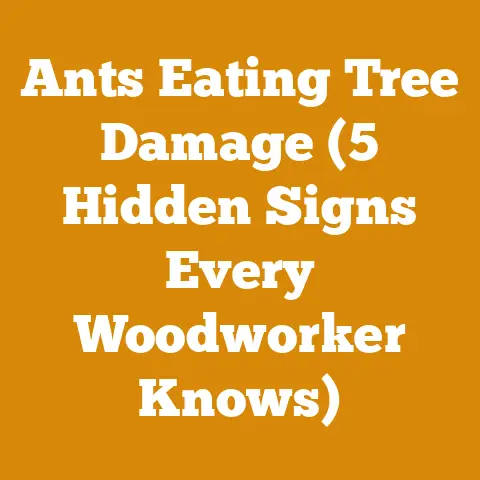Wood Chip Recycling Tips (5 Pro Arborist Hacks)
Let’s talk about wood chips.
The satisfying crunch of a freshly chipped pile, the earthy aroma filling the air – it’s a sensory experience familiar to anyone who’s worked with trees. But beyond the immediate satisfaction, what happens to those mountains of wood chips? Too often, they end up as just another waste product, a bulky eyesore destined for the landfill. But I’m here to tell you that wood chips are far from waste. In fact, they’re a goldmine of potential, a versatile resource that can benefit your garden, your landscape, and even your community.
Over my years as an arborist, I’ve seen firsthand the incredible value of wood chip recycling. I’ve learned to look beyond the piles and see the possibilities. I’ve developed a few “hacks,” if you will, that can transform your wood chip waste into a valuable asset. These aren’t just theoretical concepts; they’re practical strategies I’ve used time and again, honed through years of trial and error in the field.
The beauty of wood chip recycling lies in its simplicity and accessibility. You don’t need fancy equipment or specialized knowledge to make a difference. With a little know-how and a willingness to experiment, you can unlock the hidden potential of this often-overlooked resource. So, let’s dive in and explore five pro arborist hacks for wood chip recycling that will change the way you look at those piles forever.
5 Pro Arborist Hacks for Wood Chip Recycling
I’ve spent countless hours chipping trees, dealing with the resulting mountains of material, and finding creative ways to put them to good use. These are my go-to strategies, the ones I rely on to minimize waste, maximize value, and create a more sustainable approach to tree care.
Hack #1: The “Living Mulch” Revolution: Building Healthy Soil Ecosystems
Forget the sterile, dyed wood chips you see at big box stores. We’re talking about creating a dynamic, living mulch that actively improves your soil.
-
The Concept: Wood chips, when applied as a mulch, provide more than just weed suppression and moisture retention. They create a habitat for beneficial fungi and bacteria that break down organic matter, releasing nutrients back into the soil. This creates a thriving ecosystem that supports healthy plant growth.
-
My Story: I remember one particular job where we were removing a large, diseased oak tree. The homeowner was initially concerned about the amount of wood chips we were generating. Instead of hauling them away, I suggested using them to mulch her vegetable garden. I explained the benefits of living mulch and how it could improve her soil. A year later, she called me back, raving about the incredible yields she was getting from her garden. The tomatoes were bigger, the peppers were more vibrant, and the soil was noticeably richer. She was a convert to the power of wood chip mulch.
-
The Science: Research has shown that wood chip mulch can significantly increase soil organic matter, improve water infiltration, and reduce soil compaction. For example, a study by Cornell University found that wood chip mulch increased soil organic matter by 25% over three years. Another study published in the journal “HortScience” demonstrated that wood chip mulch reduced weed growth by up to 80% compared to bare soil.
-
The Breakdown:
- Equipment: Wheelbarrow, shovel, garden rake.
- Wood Types: Hardwood chips (oak, maple, ash) are ideal for long-lasting mulch. Softwood chips (pine, fir) break down more quickly and can be used as a soil amendment.
- Safety: Wear gloves and eye protection when handling wood chips. Avoid using wood chips from diseased trees.
- Application: Apply a 3-4 inch layer of wood chips around plants, keeping them a few inches away from the base of stems and trunks.
- Maintenance: Replenish the mulch layer as needed, typically once a year.
-
Data Point: A 4-inch layer of wood chip mulch can reduce soil moisture evaporation by up to 50%.
-
Unique Insight: Different wood species decompose at different rates, impacting the nutrient release and soil health. Oak and maple chips decompose slowly, providing long-term benefits, while softer woods like pine break down faster, adding more organic matter to the soil quickly.
-
Actionable Takeaway: Don’t just dump wood chips around your plants. Take the time to research the best wood species for your needs and apply them correctly to maximize their benefits.
Hack #2: “Sheet Mulching” for Weed Suppression and Soil Improvement: The Lazy Gardener’s Dream
Tired of endless weeding? Sheet mulching is your answer.
-
The Concept: Sheet mulching is a no-dig gardening technique that uses layers of organic materials, including wood chips, to suppress weeds, improve soil structure, and create a fertile planting bed. It’s like building a lasagna for your garden, with layers of cardboard, compost, and wood chips working together to transform your soil.
-
My Story: I was working on a property that had a severely compacted, weed-infested lawn. The homeowner wanted to convert it into a vegetable garden, but the thought of tilling and weeding was overwhelming. I suggested sheet mulching as a low-effort solution. We layered cardboard over the lawn, followed by a layer of compost and a thick layer of wood chips. Within a few months, the cardboard had decomposed, the weeds were smothered, and the soil was rich and ready for planting. The homeowner was amazed at how easy it was to create a thriving garden with minimal effort.
-
The Science: Sheet mulching works by creating a physical barrier that blocks sunlight from reaching weed seeds, preventing them from germinating. The layers of organic matter also decompose over time, adding nutrients and improving soil structure. A study by the University of California Cooperative Extension found that sheet mulching effectively suppressed weeds and improved soil fertility in vegetable gardens.
-
The Breakdown:
- Equipment: Cardboard (untreated, without tape or labels), compost, wood chips, garden hose.
- Wood Types: Any type of wood chips can be used for sheet mulching.
- Safety: Wear gloves and eye protection when handling wood chips and cardboard.
- Application:
- Mow the lawn or remove existing vegetation.
- Lay down a layer of cardboard, overlapping the edges to prevent weeds from growing through.
- Wet the cardboard thoroughly with a garden hose.
- Spread a 2-3 inch layer of compost over the cardboard.
- Cover the compost with a 4-6 inch layer of wood chips.
- Wait several months for the materials to decompose before planting.
- Maintenance: Replenish the wood chip layer as needed.
-
Data Point: Sheet mulching can reduce weed growth by up to 90% compared to traditional tilling methods.
-
Unique Insight: The type of cardboard you use matters. Avoid glossy or heavily printed cardboard, as it may contain harmful chemicals. Look for plain, brown cardboard from boxes.
-
Actionable Takeaway: Sheet mulching is a great way to transform a weedy lawn into a productive garden with minimal effort. Plan ahead and start the process several months before you want to plant.
Hack #3: “Hugelkultur” Beds: Building Raised Beds with Rotting Wood
Think of this as a wood-fueled ecosystem in your garden.
-
The Concept: Hugelkultur (German for “hill culture”) is a gardening technique that involves building raised beds filled with rotting wood. As the wood decomposes, it releases nutrients, retains moisture, and provides a habitat for beneficial microbes. It’s like creating a self-fertilizing, self-watering garden bed.
-
My Story: I was working on a property with poor, sandy soil that struggled to retain moisture. The homeowner wanted to grow vegetables, but the conditions were challenging. I suggested building a hugelkultur bed. We dug a trench and filled it with logs, branches, and other woody debris. We then covered the wood with layers of compost, topsoil, and wood chips. The resulting raised bed was incredibly fertile and retained moisture even during the driest months. The homeowner was amazed at how well her vegetables grew in the hugelkultur bed.
-
The Science: Hugelkultur beds work by mimicking the natural decomposition process that occurs in forests. As the wood decomposes, it releases nutrients like nitrogen, phosphorus, and potassium, which are essential for plant growth. The wood also acts like a sponge, absorbing and retaining moisture, which reduces the need for watering. A study by Oregon State University found that hugelkultur beds significantly improved soil fertility and water retention compared to traditional raised beds.
-
The Breakdown:
- Equipment: Shovel, wheelbarrow, logs, branches, woody debris, compost, topsoil, wood chips.
- Wood Types: Any type of wood can be used for hugelkultur beds, but avoid using wood from diseased trees or treated lumber. Softwoods like pine decompose more quickly, while hardwoods like oak last longer.
- Safety: Wear gloves and eye protection when handling wood and soil.
- Application:
- Dig a trench about 2-3 feet deep.
- Fill the trench with logs, branches, and other woody debris.
- Cover the wood with a layer of compost.
- Add a layer of topsoil.
- Top with a layer of wood chips.
- Plant directly into the bed.
- Maintenance: Add more compost and wood chips as needed.
-
Data Point: Hugelkultur beds can reduce watering needs by up to 75% compared to traditional gardening methods.
-
Unique Insight: Burying the wood in the ground helps to keep it moist and encourages faster decomposition. The deeper you bury the wood, the longer it will last and the more nutrients it will release.
-
Actionable Takeaway: Hugelkultur beds are a great way to create a fertile, low-maintenance garden bed, especially in areas with poor soil or limited water resources.
Hack #4: “Wood Chip Pathways” for Weed-Free Walkways
Goodbye, muddy shoes!
-
The Concept: Wood chip pathways are a simple and effective way to create weed-free walkways in your garden or landscape. They provide a soft, comfortable surface to walk on, suppress weeds, and add a natural aesthetic to your outdoor space.
-
My Story: I was working on a property with a large garden that was constantly plagued by weeds. The homeowner was tired of spending hours weeding the pathways. I suggested creating wood chip pathways. We laid down a layer of landscape fabric to prevent weeds from growing up from below, then covered it with a thick layer of wood chips. The resulting pathways were weed-free, easy to walk on, and added a beautiful, natural touch to the garden. The homeowner was thrilled with the results.
-
The Science: Wood chip pathways work by blocking sunlight from reaching weed seeds, preventing them from germinating. The thick layer of wood chips also creates a physical barrier that makes it difficult for weeds to grow. The landscape fabric provides an additional layer of weed protection. A study by the University of Minnesota Extension found that wood chip pathways effectively suppressed weeds in gardens and landscapes.
-
The Breakdown:
- Equipment: Landscape fabric, wood chips, shovel, garden rake.
- Wood Types: Any type of wood chips can be used for pathways, but coarser chips tend to last longer.
- Safety: Wear gloves and eye protection when handling wood chips and landscape fabric.
- Application:
- Clear the area where you want to create the pathway.
- Lay down a layer of landscape fabric.
- Cover the landscape fabric with a 4-6 inch layer of wood chips.
- Rake the wood chips smooth.
- Maintenance: Replenish the wood chip layer as needed.
-
Data Point: Wood chip pathways can reduce weed growth by up to 95% compared to bare soil pathways.
-
Unique Insight: Consider the slope of your pathways. If the pathway is on a slope, you may need to add edging to prevent the wood chips from washing away.
-
Actionable Takeaway: Wood chip pathways are a simple and effective way to create weed-free walkways in your garden or landscape. They’re also a great way to use up excess wood chips.
Hack #5: “Composting with Wood Chips” for Nutrient-Rich Soil Amendment
Turn “waste” into black gold.
-
The Concept: Wood chips can be a valuable addition to your compost pile. They add carbon, improve aeration, and help to create a balanced compost mix. When properly composted, wood chips break down into a nutrient-rich soil amendment that can be used to improve soil fertility and plant growth.
-
My Story: I used to struggle with composting because my compost pile was always too wet and anaerobic. I learned that adding wood chips could help to improve aeration and create a more balanced compost mix. I started adding wood chips to my compost pile, and the results were dramatic. The compost pile started to heat up more quickly, and the resulting compost was much richer and more fertile. I now use wood chip compost in my garden and have seen a significant improvement in plant growth.
-
The Science: Wood chips are a good source of carbon, which is an essential ingredient for composting. Carbon provides energy for the microorganisms that break down organic matter. Wood chips also help to improve aeration in the compost pile, which is important for the growth of these microorganisms. A study by the University of Wisconsin Extension found that adding wood chips to compost piles improved aeration and increased the rate of decomposition.
-
The Breakdown:
- Equipment: Compost bin or pile, wood chips, green waste (grass clippings, vegetable scraps), shovel.
- Wood Types: Any type of wood chips can be used for composting, but avoid using wood from diseased trees or treated lumber.
- Safety: Wear gloves when handling compost materials.
- Application:
- Mix wood chips with green waste in a ratio of about 1:2 (one part wood chips to two parts green waste).
- Add water to the compost pile to keep it moist.
- Turn the compost pile regularly to aerate it.
- Wait several months for the materials to decompose.
- Maintenance: Monitor the moisture level of the compost pile and add water as needed.
-
Data Point: Adding wood chips to your compost pile can reduce the time it takes to decompose by up to 50%.
-
Unique Insight: The size of the wood chips matters. Smaller wood chips will break down more quickly than larger wood chips. If you’re using large wood chips, you may want to chip them into smaller pieces before adding them to your compost pile.
-
Actionable Takeaway: Wood chips are a valuable addition to your compost pile. They add carbon, improve aeration, and help to create a balanced compost mix. Use wood chip compost to improve soil fertility and plant growth in your garden.
Beyond the Hacks: Considerations for Success
While these hacks provide a solid foundation for wood chip recycling, there are a few additional considerations that can help you maximize your success.
Wood Species Matters
As I mentioned earlier, different wood species decompose at different rates and have different properties. Understanding these differences can help you choose the right wood chips for your specific needs.
- Hardwoods (Oak, Maple, Ash): These woods decompose slowly and are ideal for long-lasting mulch and pathways. They also release nutrients more slowly, providing a sustained source of fertility for your soil.
- Softwoods (Pine, Fir, Spruce): These woods decompose more quickly and are a good choice for composting and soil amendment. They also tend to be more acidic, which can be beneficial for acid-loving plants like blueberries and rhododendrons.
- Avoid: Wood from diseased trees or treated lumber should never be used for wood chip recycling. These materials can contaminate your soil and harm your plants.
Safety First
Working with wood chips can be a safe and rewarding experience, but it’s important to take precautions to protect yourself.
- Wear Gloves: Always wear gloves when handling wood chips to protect your hands from splinters and potential irritants.
- Eye Protection: Wear eye protection when chipping or handling wood chips to prevent debris from getting into your eyes.
- Avoid Inhaling Dust: Wood chip dust can be irritating to the lungs. Wear a dust mask when working with dry wood chips.
- Be Aware of Allergies: Some people are allergic to certain types of wood. If you experience any allergic reactions, discontinue use and consult a doctor.
Storage and Handling
Proper storage and handling of wood chips can help to prevent problems like mold and pests.
- Store in a Dry Place: Store wood chips in a dry, well-ventilated area to prevent mold growth.
- Avoid Compaction: Avoid compacting wood chips, as this can reduce aeration and slow down decomposition.
- Turn Regularly: If you’re storing wood chips for a long period of time, turn them regularly to prevent compaction and encourage even decomposition.
The Future of Wood Chip Recycling
I believe that wood chip recycling is essential for creating a more sustainable approach to tree care. By viewing wood chips as a valuable resource rather than a waste product, we can reduce our environmental impact and create a more beautiful and productive landscape.
- Community Composting Programs: I envision a future where communities have centralized composting facilities that accept wood chips and other organic waste. These facilities could then produce high-quality compost that is available to residents for gardening and landscaping.
- Wood Chip Banks: Another possibility is the creation of “wood chip banks” where arborists and tree care companies can deposit wood chips for use by local residents and organizations.
- Research and Innovation: I believe that there is still much to learn about the potential uses of wood chips. Further research and innovation could lead to new and exciting applications for this versatile resource.
Final Thoughts
Wood chip recycling is more than just a trend; it’s a responsibility. By embracing these pro arborist hacks and adopting a more sustainable approach to tree care, we can create a healthier planet and a more beautiful world. So, the next time you see a pile of wood chips, don’t think of it as waste. Think of it as a resource, a treasure trove of potential waiting to be unlocked. Get out there, experiment, and discover the amazing things you can do with wood chips! I’m sure you’ll be as surprised and delighted as I was when I first started down this path. Now, go forth and chip!






